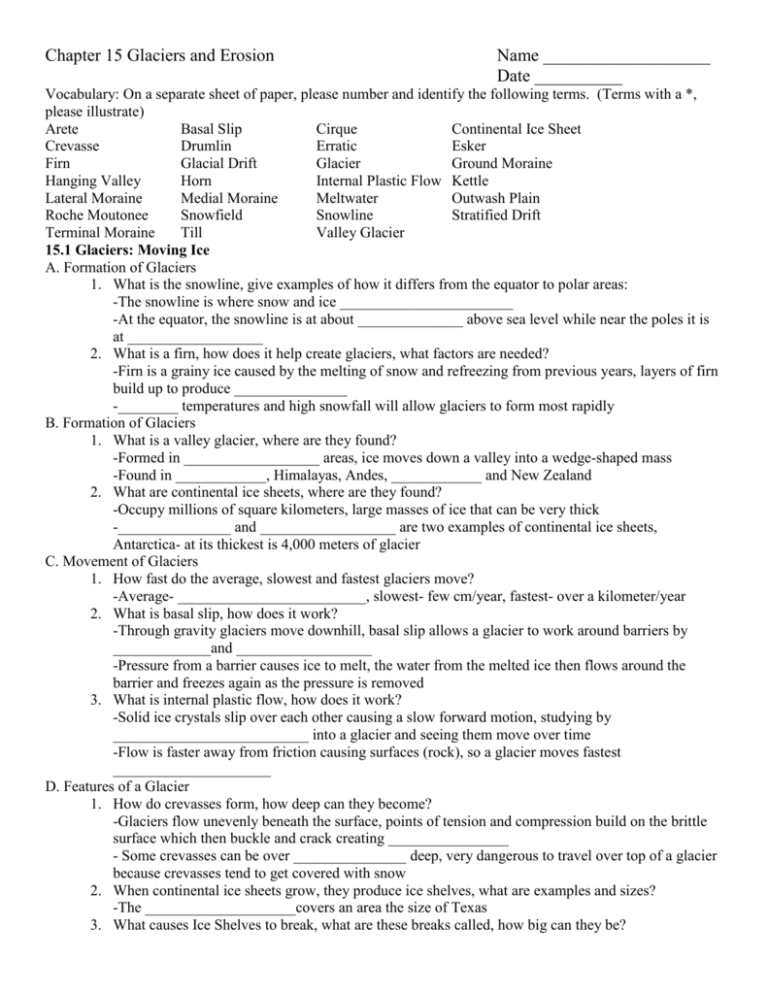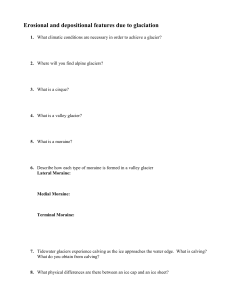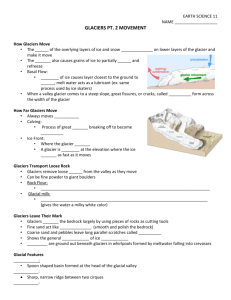Chapter 15 Glaciers and Erosions
advertisement

Chapter 15 Glaciers and Erosion Name ___________________ Date __________ Vocabulary: On a separate sheet of paper, please number and identify the following terms. (Terms with a *, please illustrate) Arete Basal Slip Cirque Continental Ice Sheet Crevasse Drumlin Erratic Esker Firn Glacial Drift Glacier Ground Moraine Hanging Valley Horn Internal Plastic Flow Kettle Lateral Moraine Medial Moraine Meltwater Outwash Plain Roche Moutonee Snowfield Snowline Stratified Drift Terminal Moraine Till Valley Glacier 15.1 Glaciers: Moving Ice A. Formation of Glaciers 1. What is the snowline, give examples of how it differs from the equator to polar areas: -The snowline is where snow and ice _______________________ -At the equator, the snowline is at about ______________ above sea level while near the poles it is at __________________ 2. What is a firn, how does it help create glaciers, what factors are needed? -Firn is a grainy ice caused by the melting of snow and refreezing from previous years, layers of firn build up to produce _______________ -________ temperatures and high snowfall will allow glaciers to form most rapidly B. Formation of Glaciers 1. What is a valley glacier, where are they found? -Formed in __________________ areas, ice moves down a valley into a wedge-shaped mass -Found in ____________, Himalayas, Andes, ____________ and New Zealand 2. What are continental ice sheets, where are they found? -Occupy millions of square kilometers, large masses of ice that can be very thick -_______________ and __________________ are two examples of continental ice sheets, Antarctica- at its thickest is 4,000 meters of glacier C. Movement of Glaciers 1. How fast do the average, slowest and fastest glaciers move? -Average- _________________________, slowest- few cm/year, fastest- over a kilometer/year 2. What is basal slip, how does it work? -Through gravity glaciers move downhill, basal slip allows a glacier to work around barriers by _____________and __________________ -Pressure from a barrier causes ice to melt, the water from the melted ice then flows around the barrier and freezes again as the pressure is removed 3. What is internal plastic flow, how does it work? -Solid ice crystals slip over each other causing a slow forward motion, studying by __________________________ into a glacier and seeing them move over time -Flow is faster away from friction causing surfaces (rock), so a glacier moves fastest _____________________ D. Features of a Glacier 1. How do crevasses form, how deep can they become? -Glaciers flow unevenly beneath the surface, points of tension and compression build on the brittle surface which then buckle and crack creating ________________ - Some crevasses can be over _______________ deep, very dangerous to travel over top of a glacier because crevasses tend to get covered with snow 2. When continental ice sheets grow, they produce ice shelves, what are examples and sizes? -The ____________________covers an area the size of Texas 3. What causes Ice Shelves to break, what are these breaks called, how big can they be? -Rise and fall of _______________ causes ice shelves to break off and become icebergs -The largest iceberg ever observed was twice the size of _______________________ E. Science and Technology 1. What is usually cited as a sign of global warming, what are to reasons for this? -Retreat of the world’s glaciers -Humans putting to much ________________________ into the atmosphere or natural cycle of climate change 2. What is radar interferometry, what is used for? -Involves comparing radar images of the same area taken a ___________________, which monitors the flow of ice -By checking ___________________ periodically, climatologists and glaciologists can judge whether large sections of ice are likely to break apart 15.2 Landforms Created by Glaciers A. Glacial Erosion 1. What are cirques, arêtes and horns, how do they form on valley glaciers -Cirque is a _____________________________ carved out by a glacier moving rocks from the floor -The sharp and jagged ridges between a cirque are called _______________ -When several arêtes are joined they form a sharp, pyramid-like peaks create a ______________ 2. How can scientists determine if a valley was shaped by a river or a glacier -Rivers create a V shaped valley, glaciers created a _______________ valley 3. How does a continental ice sheet differ than a valley glacier in eroding the land? -Continental ice sheets completely level landforms, producing relatively _______________________ landscapes 4. What direction to scratches in bedrocks point due to glaciation? -Always _________________ to the glacier movement B. Glacial Deposition 1. What are erratics, what causes them? -___________________ that have been deposited at the base of a glacier, very easy to point out because they differ from the bedrock that they’re found on 2. What is glacial drift how do they differ? -The general term for all _________________ deposited by a glacier -____________ is a glacial drift made of unsorted deposits of rock material -_____________________________ is material that has been sorted and deposited in layers by streams flowing from the melted ice (meltwater) -Soils- many soils originate as ____________________, found in Iowa and Illinois 3. What is the difference between a lateral moraine and a medial moraine? -A lateral moraine is one that is deposited ____________________ of a valley glacier -A medial moraine forms when _________________________________, their adjacent lateral moraines join forming dark stripes on the glacier surface 4. What is a ground moraine, where in the U.S. can you find it? -Made up of ___________________________ left beneath the glacier when the ice melts -Much of Ohio west to the Montana Rockies and North to Canada is covered in ground moraine 5. Why do glacial melt-waters appear milky? -Due to the presence of very fine rock particles that were ground into _________________ by glacial erosion 6. How was Minnesota affected by glaciers? -Was completely glaciated _______________________________, has evidence of all the different lake types, called the “Land of 10,000 Lakes” 7. What river does the Great Lakes drain into presently, how about in the past? -Today- _________________________________ -Past- Use to drain into _______________________ via the Wabash and Illinois rivers, lakes have shrunk in size over time and no more glacier melt in southern Canada 8. How do Salt Lakes form? -Usually in dry climates, such as the Southwestern U.S. where evaporation is ________________________ is low -Example: Great Salt Lake in Utah, used to be much larger and was called __________________________








